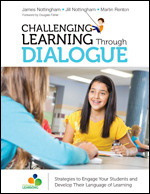Challenging Learning Through Dialogue
Strategies to Engage Your Students and Develop Their Language of Learning
Foreword by Douglas Fisher
Corwin Teaching Essentials
Using classroom discussions to teach good habits of thinking
Classroom discussion has a major effect on student learning. In fact, dialogue is one of the best vehicles for learning how to think, make moral decisions, and understand another person’s point of view. Research also indicates that most teachers talk too much in the classroom and don’t wait long enough for students to respond. How do we improve the quality of classroom discussion? Challenging Learning Through Dialogue transforms the most up-to-date research into practical strategies that work. Readers will learn
- How to build in more “wait-time” for better quality thinking and questioning from students
- How to use dialogue to teach reasoning, collaboration, and good habits of thinking
- The three types of dialogue and how to teach the most effective version: exploratory talk
- Dozens of practical strategies for exploratory dialogue
- Global examples of fun ways to teach dialogue
- An innovative new instructional strategy called Classroom Mysteries
Written by an internationally known team of educational innovators, this book is for all educators who aim to use effective classroom dialogue to engage students in learning.
"This valuable book is a must for teachers and families who wish to have their children learn to think and communicate with greater precision and clarity.”Arthur L. Costa, Ed. D., Professor Emeritus
California State University Sacramento and Co-Director, International Institute for Habits of Mind
"James Nottingham’s work on Challenging Learning is a critical element of creating Visible Learners. This new series will help teachers hone the necessary pedagogical skills of dialogue, feedback, questioning, and mindset.”
John Hattie, Professor & Director, Melbourne Education Research Institute
University of Melbourne
"James Nottingham’s work on Challenging Learning is a critical element of creating Visible Learners. This new series will help teachers hone the necessary pedagogical skills of dialogue, feedback, questioning, and mindset. There’s no better resource to encourage all learners to know and maximize their impact!"
"Challenging Learning Through Dialogue provides educators with meaningful, purposeful, and practical strategies to create high quality dialogue. Underpinned by extensive educational research, these methods will help students achieve deep level thinking and learning through the power of our language. It is inspiring, insightful, and a MUST read for all educators. Absolutely Brilliant!"

